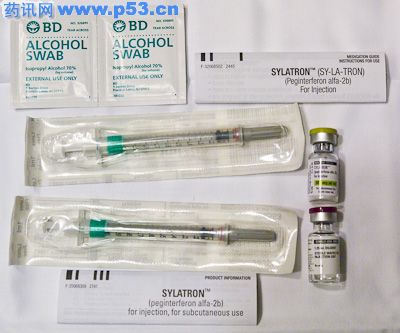|
制造商:
默克制药公司
药理分类:
阿尔法干扰素
活性成分(S):
聚乙二醇干扰素α- 2b的296mcg,444mcg,888mcg;每小瓶;为SC INJ PWD后重建。
指示(S):
辅助治疗黑色素瘤与微观或重大节点内确定手术切除的84天,包括完整的淋巴结受累。
药理:
聚乙二醇干扰素α- 2b干扰素是一种多效性细胞因子,它的机制与黑色素瘤患者施加它的影响是未知的。
临床试验:
的安全性和疗效进行了评价Sylatron在开放标签,多中心,随机进行的研究与手术切除,AJCC第三阶段在1256黑色素瘤患者在84天的区域淋巴结清扫术。患者被随机观察(无治疗)(N = 629)或Sylatron在一个由SC注射,每周一次6mcg/kg对于由3mcg/kg SC注射一次剂量8周后剂量(N = 627),为期长达5年的总治疗。该Sylatron剂量调整,以保持在0至1 ECOG体能状态。主要结果测量是无复发生存率(RFS),为从随机到任何复发的最早日期(地方,区域,在途,或远)时间的定义,或从任何导致死亡。二次结果措施包括总生存期。
根据696 RFS事件,由独立评审委员会决定,RFS中位数为34.8个月,25.5个月在Sylatron和观察武器,分别。有没有生存的统计学意义的Sylatron和观察武器的区别。
法律分类:
接收
成人:
≥18yrs:给由SC INJ。旋转INJ网站。 Premedicate与对乙酰氨基酚。 6mcg/kg/week由3mcg/kg/week随访长达5年8剂量。扣压剂量如果ANC <0.5x109 / L,血小板<50x109 / L,ECOG PS≥2,或对非血液学毒性≥3级。在降低剂量简历(见文献)当:ANC≥0.5x109 / L,血小板≥50x109 / L,ECOG PS 0-1,和非血液学毒性已完全解决或改善,以1级。
儿童:
<18yrs:不推荐。
禁忌(S):
过敏性反应,以聚乙二醇干扰素α- 2b干扰素或干扰素α- 2b干扰素。自身免疫性肝炎。肝功能失代偿(Child - Pugh评分> 6 [B级和C])。
警告/注意事项:
风险增加神经精神疾病(如抑郁,自杀意念)。永久停止为:严重或持续恶化的神经精神障碍(如抑郁症,精神病,脑病);新发室性心律失常,心功能失代偿,新的或视网膜病变恶化,严重(3级)肝损伤或肝功能失代偿;甲状腺功能低下,甲状腺功能亢进或糖尿病或者如果无法忍受的1mcg/kg/week剂量;不能有效地管理糖尿病。监测标志/抑郁症/在第8周,每3周精神病的症状,然后每6个月,至少持续6个月后最后一次剂量。在执行过程中与视网膜病变和视力变化治疗的患者眼科检查。监测血清胆红素,ALT / AST,碱性磷酸酶,和LDH在2和8周,2和3个月后开始,然后每6个月肝功能。获得4个星期内TSH水平之前启动,在3和6个月后开始,然后每6个月。妊娠(Cat.C)。哺乳母亲:不推荐。
交互(S):
由CYP2C9或CYP2D6代谢药物的治疗效果可能会改变。
不良反应(S):
疲劳,增加ALT / AST,发热,头痛,厌食,肌肉痛,恶心,寒战,注射部位反应。
如何提供:
单用小瓶- 1,4(W.稀释剂)
最后更新:
2011年6月23日




2011年3月29日,美国食品和药品监督管理局批准聚乙二醇干扰素α-2b [聚乙二醇干扰素α-2b](Sylatron, 先灵公司Schering Corporation, Kenilworth, NJ 07033),为治疗最终手术切除包括完整的淋巴结清扫术84天内有显微镜或大体肉眼累及淋巴结黑色素瘤患者。
批准是根据单项试验,EORTC 18991,一项开放,多中心试验纳入1256例患者。原发皮肤黑色素瘤和受影响的区域淋巴结已被适当地切除患者被随机化(1:1)至接受或 Sylatron或观察为期5年。分层因素包括累及淋巴结类型(显微镜相比大体肉眼),阳性淋巴结数(1,2-4,5或更多,或未评估),Breslow 原发厚度(小于1.5 mm,≥ 1.5至4 mm,≥ 4 mm),原发肿瘤的溃疡(存在或缺乏或未知),性别,和研究中心。对治疗的头两年每三个月和随后每6个月直至试验结束,评估患者局部和区域复发或远处转移。一个独立审评委员会,对随机化赋予盲态和告知将破坏治疗的盲态,审评来自数据的病例报告以确定局部-区域复发,或远处转移的发生和日期。
主要疗效终点,无复发生存(RFS),被定义为至最早局部或区域复发,远处转移,或死亡的时间。根据696次RFS事件,对Sylatron-治疗患者 RFS改善[风险比0.82(95% CI:0.71,0.96);观察到不分层log-rank p = 0.011]。 在SYLATRON和观察组中估算的中位RFS分别为34.8个月(95% CI:26.1, 47.4)和25.5个月(95% CI:19.6,30.8)。 对研究后525例死亡,Sylatron和观察组间总生存无差别[风险比0.98(95% CI:0.82,1.16)]。
在EORTC 18991中评价608例Sylatron-治疗患者的安全性。Sylatron-治疗患者经受最常见(>60%)1-4级不良反应是疲乏,ALT 增高,AST增高,发热,头痛,厌食,肌肉痛,恶心,畏寒,和注射部位反应。发生在Sylatron-治疗患者中最常见严重不良反应是疲乏,ALT增高,AST增高,和发热。
接受Sylatron患者中33%由于不良反应终止治疗。治疗终止时存在的最常见不良反应是疲乏,抑郁,厌食,ALT增高,AST增高,肌肉痛,恶心,头痛,和发热。Sylatron末次给药的30天内报道5例死亡。2例归咎于复发疾病,两例归咎于心血管疾病可能与Sylatron有关,和一例归咎于意外。
对Sylatron推荐的剂量和方案是6 μg/kg/周,皮下共 8剂,接着皮下3 μg/kg/周。最长治疗期是5年(260周)。

SYLATRON
Manufacturer:
Merck & Co., Inc.
Pharmacological Class:
Alpha interferon
Active Ingredient(s):
Peginterferon alfa-2b 296mcg, 444mcg, 888mcg; per vial; pwd for SC inj after reconstitution.
Indication(s):
Adjuvant treatment of melanoma with microscopic or gross nodal involvement within 84 days of definitive surgical resection including complete lymphadenectomy.
Pharmacology:
Peginterferon alfa-2b is a pleiotropic cytokine; the mechanism by which it exerts its effects in patients with melanoma is unknown.
Clinical Trials:
The safety and efficacy of Sylatron were evaluated in an open-label, multicenter, randomized study conducted in 1,256 patients with surgically resected, AJCC Stage III melanoma within 84 days of regional lymph node dissection. Patients were randomized to observation (no therapy) (n=629) or to Sylatron (n=627) at a dose of 6mcg/kg by SC injection once weekly for 8 doses followed by a 3mcg/kg SC injection once weekly for a period of up to 5 years total treatment. The dose of Sylatron was adjusted to maintain an ECOG Performance Status of 0 to 1. The main outcome measure was relapse-free survival (RFS), defined as the time from randomization to the earliest date of any relapse (local, regional, in-transit, or distant), or death from any cause. Secondary outcome measures included overall survival.
Based on 696 RFS events, determined by the Independent Review Committee, median RFS was 34.8 months and 25.5 months in the Sylatron and observation arms, respectively. There was no statistically significant difference in survival between the Sylatron and the observation arms.
Legal Classification:
Rx
Adults:
≥18yrs: Give by SC inj. Rotate inj sites. Premedicate with acetaminophen. 6mcg/kg/week for 8 doses, followed by 3mcg/kg/week for up to 5 years. Withhold dose if ANC <0.5x109/L, platelets <50x109/L, ECOG PS ≥2, or for non-hematologic toxicity ≥ Grade 3. Resume at reduced dose (see literature) when: ANC ≥0.5x109/L, platelets ≥50x109/L, ECOG PS 0–1, and non-hematologic toxicity has completely resolved or improved to Grade 1.
Children:
<18yrs: not recommended.
Contraindication(s):
Anaphylaxis to peginterferon alfa-2b or interferon alfa-2b. Autoimmune hepatitis. Hepatic decompensation (Child-Pugh score >6 [Class B and C]).
Warnings/Precautions:
Increased risk of neuropsychiatric disorders (eg, depression, suicidal ideation). Permanently discontinue for: persistent severe or worsening neuropsychiatric disorders (eg, depression, psychosis, encephalopathy); new onset ventricular arrhythmia, cardiovascular decompensation; new or worsening retinopathy; severe (Grade 3) hepatic injury or hepatic decompensation; hypothyroidism, hyperthyroidism, or diabetes mellitus that cannot be effectively managed; or if unable to tolerate a dose of 1mcg/kg/week. Monitor for signs/symptoms of depression/psychosis every 3 weeks during first 8 weeks, then every 6 months, continue for at least 6 months after last dose. Perform eye exam in patients with retinopathy and those with vision changes during therapy. Monitor hepatic function with serum bilirubin, ALT/AST, alkaline phosphate, and LDH at 2 and 8 weeks, and 2 and 3 months following initiation, then every 6 months. Obtain TSH levels within 4 weeks prior to initiation, at 3 and 6 months following initiation, then every 6 months. Pregnancy (Cat.C). Nursing mothers: not recommended.
Interaction(s):
Therapeutic effect of drugs metabolized by CYP2C9 or CYP2D6 may be altered.
Adverse Reaction(s):
Fatigue, increased ALT/AST, pyrexia, headache, anorexia, myalgia, nausea, chills, inj site reactions.
How Supplied:
Single-use vial—1, 4 (w. diluent) | 





